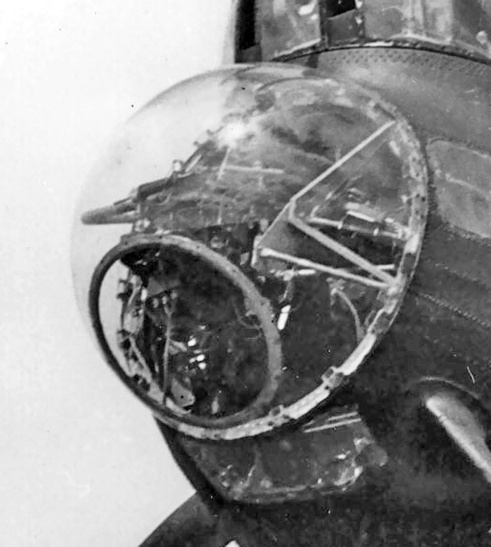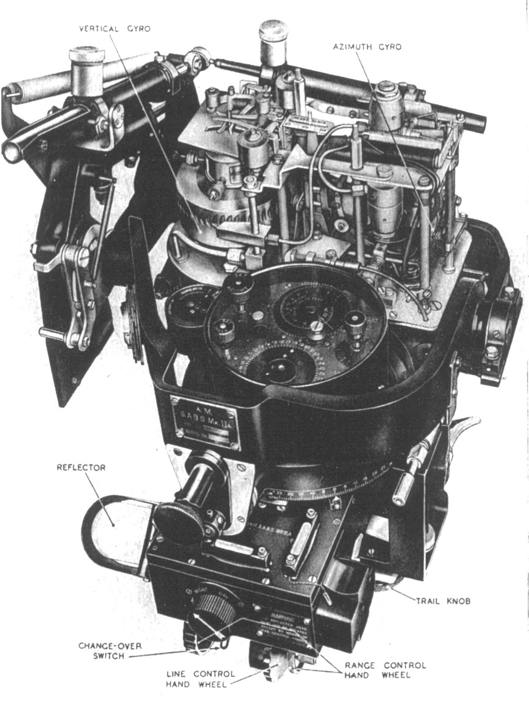 Bomber Command
Bomber Command  |
Aircrew Chronicles
|
Aircrew Losses
|
Nose Art
|
BCATP
|
Lancaster
|
Media
|
Aircrew Chronicles
|
Aircrew Losses
|
Nose Art
|
BCATP
|
Lancaster
|
Media
 Bomber Command
Bomber Command  |
Aircrew Chronicles
|
Aircrew Losses
|
Nose Art
|
BCATP
|
Lancaster
|
Media
|
Aircrew Chronicles
|
Aircrew Losses
|
Nose Art
|
BCATP
|
Lancaster
|
Media
The Stabilized Automatic Bomb Sight (SABS) was a precision instrument that had been under development for some time prior to first being utilized in 1944. It was designed to provide greater accuracy from high altitude than the Mk. XIV/T-1 bombsight that was generally being used by the bomb-aimers during this period of the war. In conjunction with this more advanced bombsight, Barnes Wallis was designing the Tallboy and Grand Slam bombs that would require very accurate placement. The SABS was stabilized by a gyroscope and incorporated a complex mechanical computer that was able to calculate its own wind corrections which the Mk. XIV/T-1 could not. After generating automatic aiming instructions for the bomb aimer, the SABS was then able to automatically release the bomb. These were qualities it shared with the American designed Norden bomb sight. A number of factors had to be precisely measured prior to being utilized within the bombsight to attain the accuracy required. The aircraft's groundspeed, airspeed, and altitude had to be determined and, as well, the outside air temperature at the point of release was critical. This indirectly indicated air density and an error of one degree (Celsius) would result in a bombing error of twenty-one feet. It was found that attaining this measurement was not a simple matter as air passing over a thermometer creates heat by friction. However, a system was devised to determine an accurate temperature. |
 in the bomb aimer's perspex dome of a 617 Squadron Lancaster. |
As the target was approached the pilot had to hold his exact course for about ten miles while the flight engineer manipulated the throttles to maintain a constant speed. This need to fly straight and level ruled out any evasive action leaving the aircraft vulnerable to radar-predicted flak and fighter attacks during the bomb run.
As soon as the bomb aimer had the sight's cross hairs on the target, he clicked a switch and the SABS used its gyroscopes to assist in the tracking the target. It was found that considerable practice was required by the bomb aimers to maintain accuracy.
S/Ldr. Joe McCarthy, an American in the RCAF, had flown on the Dams Raid and was a 617 Squadron Flight Commander when the SABS and Tallboy bombs became operational. Johnny Johnson, Joe's bombaimer, described using the SABS as follows, "You set on height and groundspeed and you then manipulated the target light with a couple of handles so that you got it in line with the target and as the target came into the light these two points on the bombsight came together and the bomb was released."

|
Joe described the instrument that he used in the cockpit so that he could fly the aircraft to the release point that was determined by the SABS, "There was a little thing in front of my eyes with a zero, and then there was 1, 2, 3, and 5 on the left and 1, 2, 3, and 5 on the right and this needle would go back and forth. Now wherever that needle was, it meant that I had to bring that needle back (to zero)." The SABS was a much more complex sight to use and to maintain than the Mk. XlV/T1 and required many more man-hours to manufacture. Its success was said to have been largely due to S/L Don Richardson who joined 617 Squadron during August 1943 in order to train the crews to use the new device. S/L Richardson became known as, "Talking Bomb." It was said that he spoke of nothing else but the SABS from dawn until dusk. He flew on eight raids in order to watch his bomb sights in operation. For all the other squadrons in Bomber Command, the Mk. XlV/T1 was quite adequate for their operations. The accuracy that 617 Squadron was able to attain with the SABS was truly remarkable. Their bombs were generally dropped from 18,000 feet while flying at a speed of 200 mph and several miles back from the target. From that height and distance even the white square on the bombing range looked like the size of a pin-head. Although it was claimed during the war that an American bombardier using the Norden Bomb Sight could drop a bomb into a "pickle barrel" from six miles up, this was of course a myth. USAAF bombardiers were never able to match the accuracy developed by 617 Squadron's bomb aimers using the SABS. |
In fact, as Joe recalled, "Now the Americans with the Norden sight said that they could put a bomb in a pickle barrel but this was crazy. They came to visit us when they started bombing, Eaker and another two (Lt. General Ira Eaker was the Commanding Officer of the United States Eighth Air Force which was the American's bomber force based in Britain). They visited us and watched what we were doing and watched us bomb. They were amazed at the consistency-75 yards or less from 20,000 feet.
"Somebody made a caustic remark about this pickle barrel bombing and I think it was Cheshire who said, 'Well, let's have a competition. We'll put up three crews and you put up three crews and we'll see who comes out the best.' They wouldn't do it."